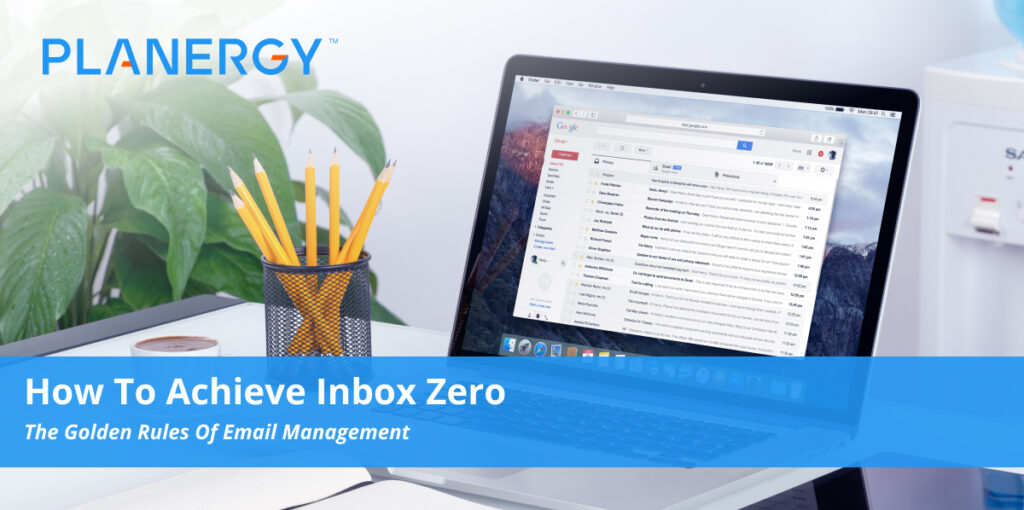If you open your email inbox every day to find hundreds of new emails – and the total number of read and unread messages is well into the thousands, you’re not alone. Many of us deal with “email overload.”
Because email is the predominant form of business communication online today, it’s easy to get an overwhelming amount of correspondence every day. And if you don’t get a handle on it now, it’ll continue to snowball.
The Inbox Zero approach, first coined by productivity expert Merlin Mann in his book, Inbox Zero: Cutting Through the Crap to Do the Work That Matters, didn’t have a literal meaning of keeping your inbox empty. Instead, it was meant as a productivity booster, so you could reclaim your attention, your email, and your life.
It has since morphed into a more literal definition – the idea of constantly keeping your inbox empty.
Many choose to follow HubSpot’s definition: “the process of labeling, triaging, and organizing your email box with a system that allows you to reach and maintain zero unread emails awaiting reply in your inbox.”
Regardless of the definition you choose to follow it is something many of us aspire to achieve but don’t consider it possible.
Let’s take a look at how you can take back control of your email box and make the most of your time at work every day.
Principles of the Inbox Zero Philosophy
Before you get started working toward Inbox Zero, make sure you understand the five rules to live by while tackling your email.
Not All Emails are Created Equal
As with most things in life, the Pareto principle holds true when it comes to email as well. Generally speaking, about 20% of our email consumes about 80% of our focus.
The rest is just a waste of time. Instead of trying to fight it, focus on those emails that need your attention and quickly address the remainder.
Our Time is Valuable
No matter what we do, we will never be able to read and take action on all of the emails we receive.
We will always receive more than we will be capable of responding to.
The sooner we acknowledge that we can’t handle it all, 100% of the time, the sooner it is easier to concentrate on the emails that matter at the right time and finish the rest at another time.
Keep it Simple and Scannable
When you send an email, remember that you’re not sending an essay or a book. It’s okay to send a single-line email. If it gets to be too long, rely on bullets.
Break up large blocks of texts so it becomes easier to scan and read.
Focus Not on the Emotion, But the Action
Everyone gets overwhelmed from time to time, especially if they open an email box to tons of email messages that are unread.
Instead of focusing on the feeling, we have to focus on the action of doing.
Set Honest and Realistic Expectations
Before you can consider inbox zero achieved, you have to be honest with yourself about where your priorities are.
You must also develop realistic time expectations. Use your gut instinct to determine which emails deserve a response and which can be deleted.
And if that fails, use the subject line. It can be difficult, but you have to learn when to say no if you want to achieve inbox zero.
Achieving inbox zero isn’t about an empty inbox, so much as it is a better approach to overall email management. It’s not about the amount of time you spend categorizing emails – it’s about ensuring the emails that need your attention get it.
Getting to Inbox Zero
Schedule Times to Deal with Email Throughout the Day
Every time you stop a tax check your email, your brain takes a few minutes to get back on task. If you do this too much, you’ll break your productivity, waste time, and won’t get anything done.
You’ll end up with a pile of unaccomplished work and a ton of messages in your email box that need to be dealt with one way or another.
That’s why you should set aside a couple of blocks of time in the morning and before you leave the office for the day to handle your email box.
If you’re tempted to look every time you receive a notification, use the snooze feature (which isn’t available in Outlook) in Gmail or turn off email notifications on your phone and computer.
If you’re worried about missing any kind of incoming urgent message, take a few minutes to build custom notifications that will alert you only about the highest priority messages that cannot wait a couple of hours until your next scheduled check-in time.
Ultimately, you’ll be able to more efficiently manage your email because you’ll tackle it in multiple smaller blocks of time.
And, by ignoring it outside of those times, you’ll be able to use the rest of your day more productively on the more important tasks, without those interruptions.
Triage Everything as it Arrives – Within Your Scheduled Window
You need to tackle everything as it comes in, as best you can. When you receive new emails outside of your scheduled check-in times, it may build-up, which makes the triage process that much more important for your success.
When it’s time to address your inbox on one of your scheduled email breaks, as you look at each email apply one of the following three rules:
- If it’s a message that requires no action on your behalf, immediately archive it.
- If the message requires a simple reply that you can knock out in 60 seconds or less, respond right in there and then archive it.
- If the message requires a response that you can’t get you right away, snooze it to a date and time when you’ll be able to handle it. It could be later that day, a day next week, or two months from now. Either way, it gets the message out of the way so it’s not a distraction. Then, when the time is right, it will reappear so you can follow up accordingly.
This methodology keeps you from accidentally deleting incoming messages that you may need to read because nothing is sent to the trash.
The Google Inbox app has a native snooze function. if you want to add that function to Gmail, there are several add-ons available to choose from.
Generally, you should aim to never open an email twice and never leave in the mail in your box beyond a single day. This way you can spend time getting things done (GTD).
Treat Email as a Messaging Service
The secret is to consider your email as a messaging service. Think about how you could compose your message if it were a text. You can make it a touch more formal and add pleasantries where they are appropriate and you’re finished.
Aside from saving yourself time and letting you move through incoming email more efficiently, this approach makes your outgoing emails more effective. You’ll be making it easier for the recipient to read your message understand what you want and then fire off a quick reply.
Of course, there are always exceptions to the rule. If you’re describing a project proposal or writing to your best friend, it’s okay to get a bit wordy. But, it’s something you should keep in mind for the majority of your emails especially when it comes to work email.
Make Use of Canned Responses
Canned responses are essentially email templates you can use to stop yourself from having to write the same things over and over again. Everyone has a set of standard messages that we write over and over again either for work or personal email.
Whether it’s making an introduction, sending an expected document, or declining an invitation, you are likely wasting time every time you have to write it out repeatedly.
Nearly every email service has a kind of system for creating and making use of templates. Take a few minutes to create templates for all of your recurring messages so that in the future, all it takes is a click.
Make Use of Filters
For most people, the vast majority of your incoming email Isn’t all that useful. Anything you need to know or requires a response is what’s pertinent.
That’s why, for the next week, you should aim to unsubscribe from every list-based email you get unless you have a true need or benefit as a result of receiving it.
You can also use services that will help you mass unsubscribe to numerous lists. some Services even exist to roll all of the options you have into a single email you received every day to make it easier for you to read through everything.
If you have any recurring messages that you can’t easily unsubscribe from, create filters to automatically place them in out-of-the-way areas. If you use Google’s Inbox, it is designed to do this with built-in sections like updates, social, and promos.
In the settings, you can choose for those emails to appear only once a day, or once weekly.
Gmail has an option for a similar set of Auto sort of categories but it’s not as powerful and intuitive as Google’s Inbox.
In the future, if you ever need to subscribe to a list, you may want to consider using a disposable email address so that it does not clog up your actual inbox.
Some email services like Yahoo offer these disposable email addresses right from within your inbox. it’s okay to use those for emails associated with rewards clubs or other online accounts that you don’t use very often.
Inbox or Gmail users can create a virtually infinite number of aliases by placing a period anywhere in the username or placing a plus sign followed by a word at the end of your username.
This gives you a variable for creating scenarios specific filters to keep those inconsequential messages from turning into a time suck.
If you know emails from certain senders will never be relevant to you, you can create a manual filter to send them directly into your spam or trash.
You can also create manual filters that automatically route emails from certain senders to folders within your email box.
Learn Advanced Search Options
The fastest way to find an old email is to search for it. Sure you can take time to organize your email into folders but that’s really making unnecessary extra work for you.
Instead of worrying about organizing everything into folders that are properly labeled, you can just archive it all. Archiving your mail doesn’t delete it, but removes it from the inbox so there’s less to focus on.
Then, when you need to sign find something again in the future you can search for it.
Take some time to learn your email client’s advanced search parameters so that you can take advantage of all that is available to you. Gmail and Inbox have robust options that make it easy to find old emails in a matter of seconds.
All of these tactics work toward the goal of turning your inbox into a place that is for messages that actually require attention. By eliminating the less important and time-consuming clutter, you’ll be able to focus your attention where it really matters.
With the cluttered email inbox out of the way… you’ll soon be ready to handle your social media so that you can stay as productive as possible




